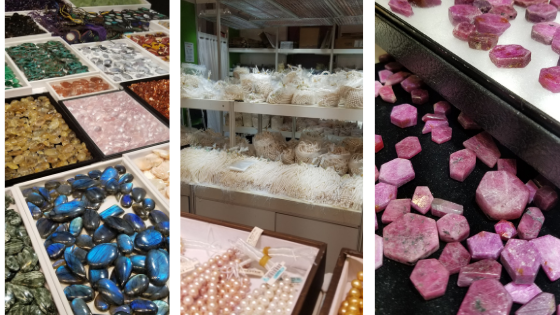Returning from Tucson - What I learned about ethically sourced gemstones


Tucson is the Mecca of the jewelry industry. I make the trip every single year - it’s been almost a decade.
Yes, it’s about restocking my supplies and getting inspired for new designs. The reason I go is also because of the tequila, tacos, and uninterrupted girl time with my 2 favorite jewelry designer friends.
That’s what Tucson is about to me.
But what does this gemstone show mean to you, as a client of mine? This is where I go to find the highest quality, ethically sourced gemstones for your pieces.
You might be wondering why I use ethically sourced gemstones or what that even means.
Ethically sourced gemstones are stones that aren’t involved in unsafe, unethical conditions for any worker or environment involved in the extraction, transportation, cutting, polishing, and overall process of bringing the stone from the earth to your hands.
I get it, no one wants a blood diamond - but how do you know for sure where yours came from?
Those same questions run through my mind as I walk the shows and slowly get overwhelmed by the sheer magnitude of the event.
Vendors sell their stones anywhere they can stake out a piece of ground for their booth. I’m not kidding. There are endless rows of tents lining parking lots, ball rooms, convention centers, and even hotel rooms.
It’s a madhouse of sparkle and shine, leaving you craving salt and lime when 8pm rolls around.I can’t help but wonder where all these stones came from.
Who digs all this stuff out of the ground? Who cuts and polishes the stones? Are they real? Are they dyed or enhanced? Were the people involved in producing it treated well? Did they have ventilation where they were cutting? Did they get paid well? Were they children? Are these really rare or did they just say that? Is this synthetic sapphire or real? Why is that one $5 a carat and that one $15 per carat? What is involved in mining these? Does it damage the earth? Were harsh chemicals used? Were habitats destroyed?
Answering these questions gives you an idea if the stone was sourced ethically or not.
A common misconception is that it’s just about responsible mining. There are a hundred ways a gemstone can be involved in unethical sourcing methods, making it really hard to know for sure what the story of the stone really looks like.
Mining, cutting, and polishing, these are not simple processes. Many stones come from countries and areas that don’t have laws in place for practicing safe, humane extraction.
This makes it unlikely they were ethically sourced, and even harder to prove. It’s easier for designers to turn a blind eye to how the gem got there and just focus on quality or price.
I’m challenging myself to put ethical sourcing above most other factors so I know my business is supporting humane practices across the globe.
A daunting task, I know.Thankfully, with the rise of technology and instant communication and tracking anywhere in the world, it’s getting easier to be confident in your purchase.
One step I took during this trip is to select stones that were cut and polished in the US. Not that other countries can’t do this ethically, but the tracking process is better documented.
Even this isn’t a perfect solution, though, because the person buying rough gemstones can’t always be sure where it came from. For example, at least I’m confident the cutter was paid well and worked in a studio with proper ventilation.
Moving forward, I will be digging in deeper. Taking on more responsibility with the stones I choose to buy.This means a more expensive, smaller selection, but I believe the best way to support a cause is with your buying decisions.
It’s one thing to care about people and the planet, but when it comes down to it, I want to put my money where my mouth (and heart) is.
When I see these tables filled with inexpensive stones, my heart sinks and my first thought it, “how?”
If you’re selling bags of pearls, they can’t be coming from a great place. When I buy pearls, I choose to pay more because I think they’re better sourced and higher quality.
Not only are these stones potentially unethically sourced, but they also might be fake. I always shy away from too good of a deal, because it’s probably not a good deal in the end.
One of my proud purchases from this show are these rubies from a stone vendor I trust to be safe and cruelty free.

I’m still dreaming up the designs for these rubies. Click here to message me about designing a custom piece with them for you!
Everything I’m learning about ethically sourced gemstones makes me even more passionate about spreading awareness. Not just to jewelry designers, but to the people who end up wearing the jewelry.
You deserve to know what you’re wearing everyday, and so does everyone you know. Share this blog with someone to help spread the news and increase demand for ethically sourced gemstones!

Hi, Allison. These rubies are absolutely fabulous!!! I love to talk about a pendant to work with the pink earrings I bought from you. I love your bold, industrial look.
As a jewelry designer I want to thank you for sharing your knowledge and making me more aware of my purchases. I will be much more careful in buying jewelry that I personally wear as well as what I use in my designs for sale.